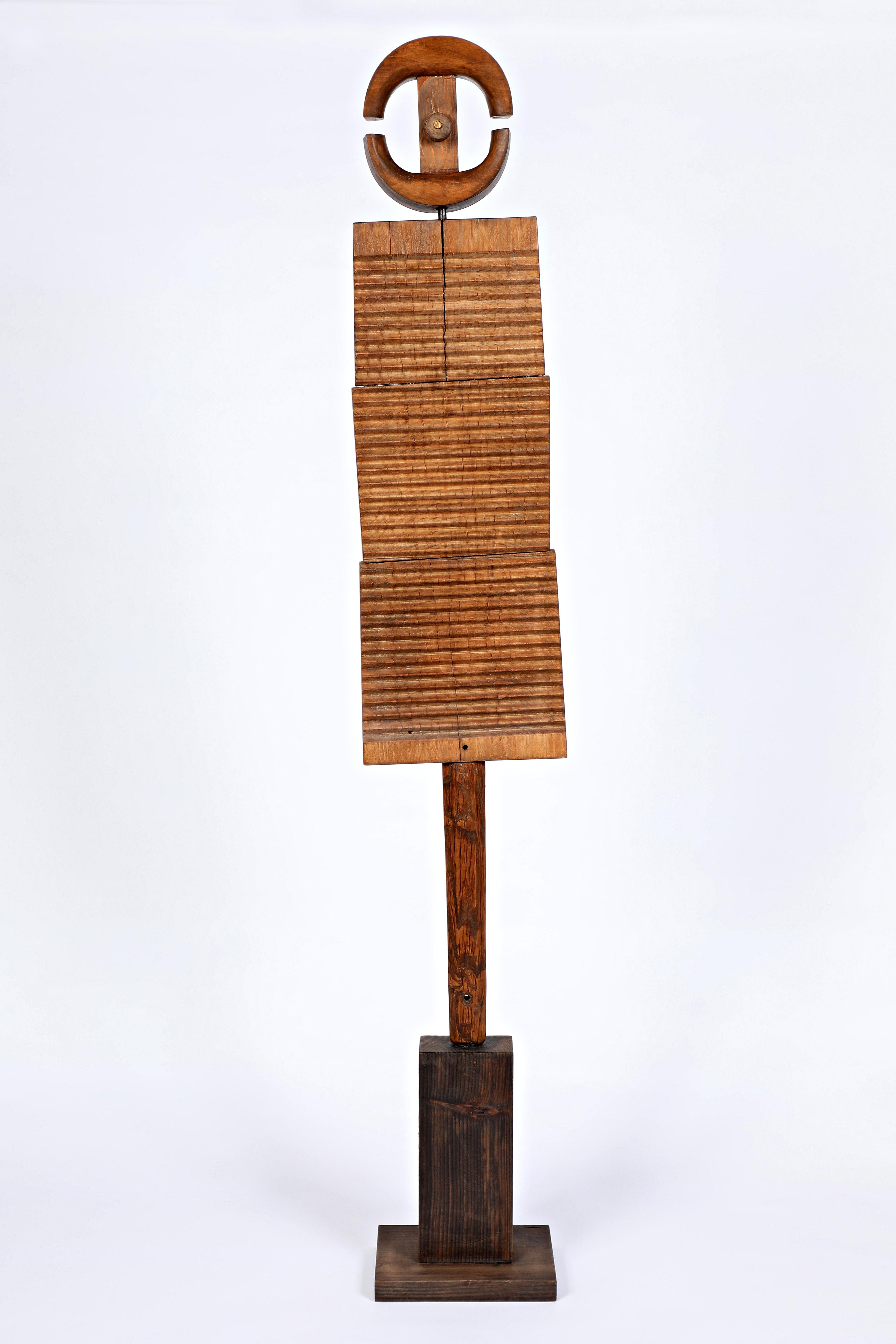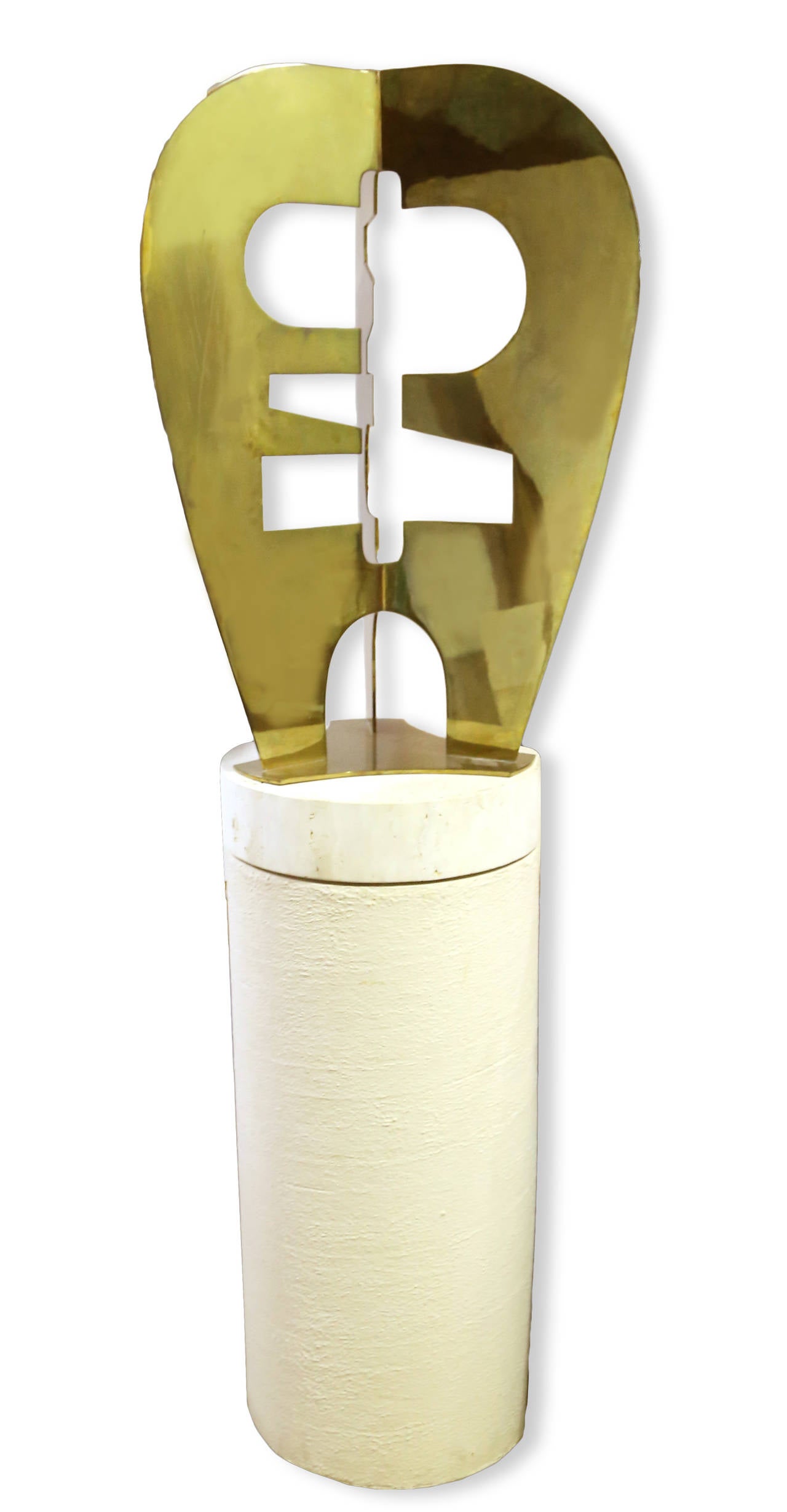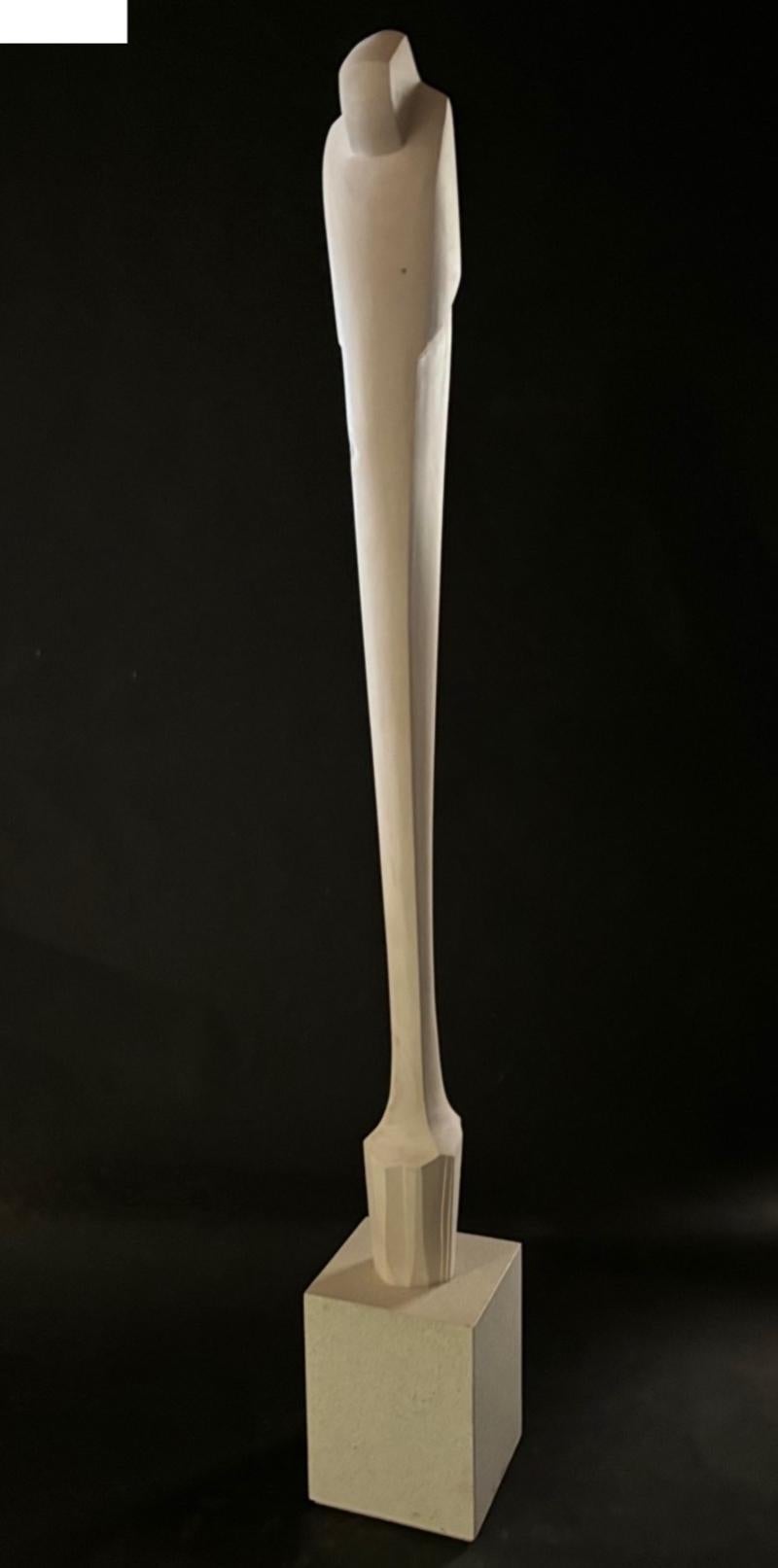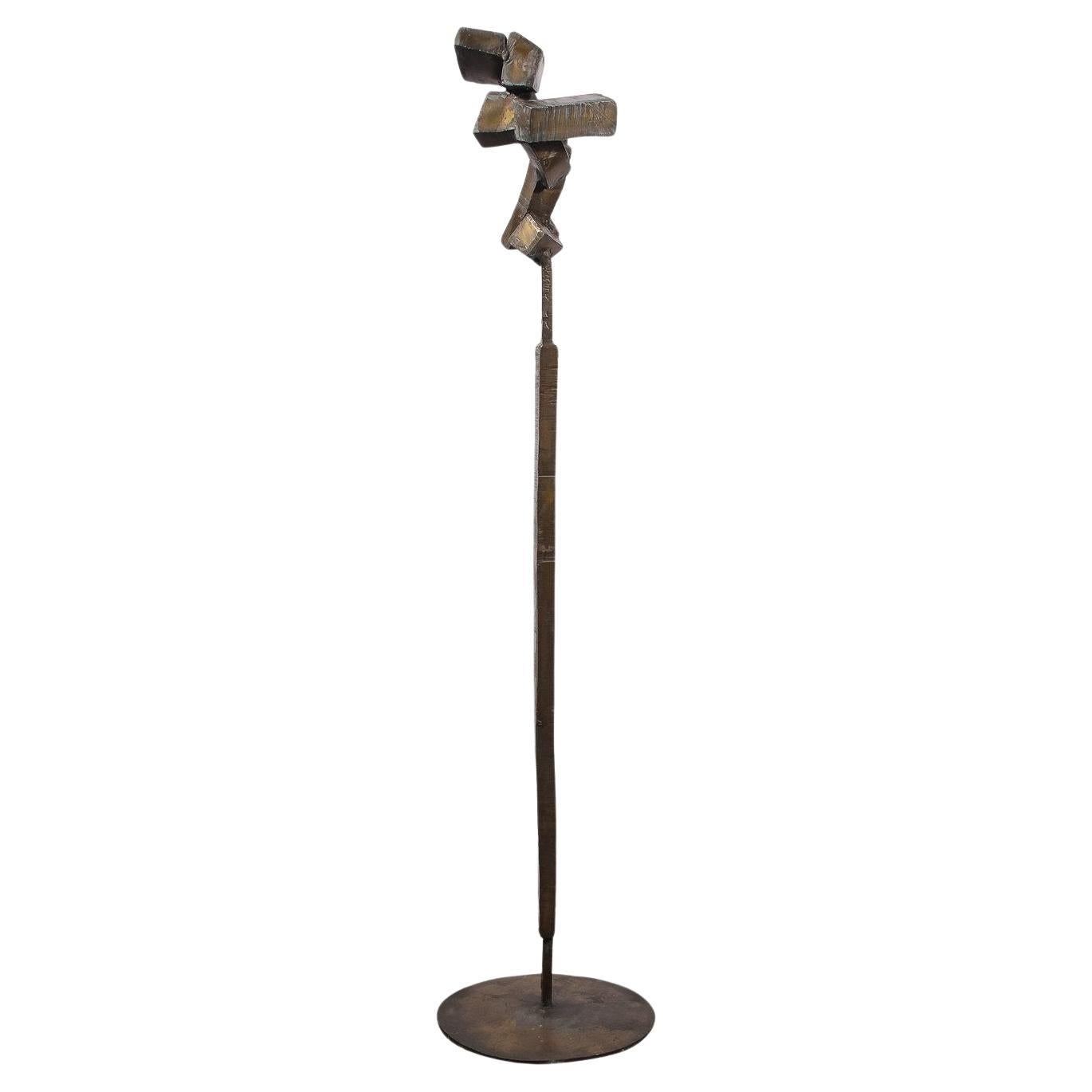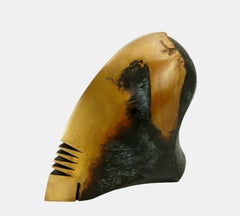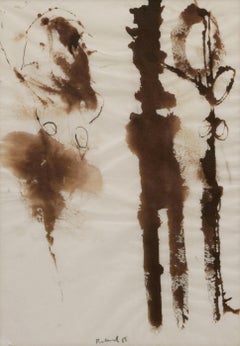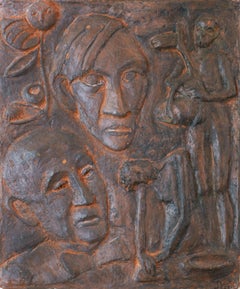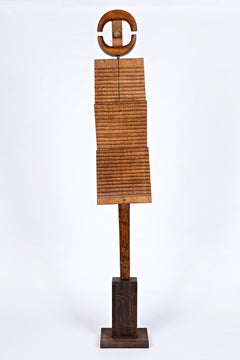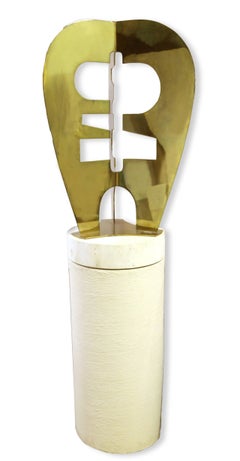Items Similar to Vegetative Form / - Grown Art -
Want more images or videos?
Request additional images or videos from the seller
1 of 8
Paul DierkesVegetative Form / - Grown Art -1958
1958
$3,326.38
$4,157.9720% Off
£2,495.39
£3,119.2420% Off
€2,800
€3,50020% Off
CA$4,605.61
CA$5,757.0120% Off
A$5,005.50
A$6,256.8820% Off
CHF 2,682.49
CHF 3,353.1220% Off
MX$60,775.71
MX$75,969.6420% Off
NOK 33,677.07
NOK 42,096.3420% Off
SEK 31,230.36
SEK 39,037.9620% Off
DKK 21,330.80
DKK 26,663.5020% Off
About the Item
Paul Dierkes (1907 Cloppenburg - 1968 Berlin), Vegetative Form. Mahogany, 1958. 142 x 16 x 10 cm (sculpture), 21 x 17.5 cm (base), monogrammed "PD" on the reverse.
- Grown Art -
In addition to stone, wood fascinated Paul Dierkes. Unlike the more homogeneous material of sedimentary rock, wood has an inner structure due to its organic growth, which Dierkes transforms artistically. Even the narrow, tall form looks as if it has grown. The thin iron base suggests the soil from which the form grew. It does not need a more extensive foundation for its own internal support, although it is by no means bulky, but has a slender elegance. It tapers in the middle and then widens again, creating a symmetrical overall form whose lightness and perfection recall Constantin Brancusi's The Bird in Space (1923). In contrast to the smooth perfection of the overall form, which is completely harmonious, Dierke's work shows a differentiated formation of form that results from the inner necessity of growth: The lower part appears as a shaft, while the thinner but slightly wider upper part, with its two indentations, resembles a leafy crown. The lower part is connected to the upper part by a stylized consolidation of the form, which swings back into a vertical hollow, so that the inner forces of the organic form seem to be concentrated here. The grain, discoloration and cracks of the mahogany wood in particular contribute to the impression of organicity. They lend the dominant overall form the delicate structure of real growth, nourishing the effect of an inner vitality.
In keeping with the title "Vegetative Form," Dierkes has created a primal form of nature that, in analogy to Karl Blossfeldt's photographs that reveal the structure of nature, is also a primal form of art. Once again, in contrast to Brancusi's smoothness, the clear traces of processing are part of the aesthetic appearance, which - in addition to the natural organicity - emphasizes the aspect of the created work of art. Nature transformed into art, revealing new aspects of its original organic form with every twist and turn in the play of light.
About the arist
As the son of a stonemason, Paul Dierkes was familiar with stone from an early age. After an apprenticeship as a stonemason, he decided to explore this material artistically and become a sculptor. He first studied at the Königsberg Art Academy under Stanislaus Cauer. In 1931 he transferred to the Munich Academy and received a scholarship to Rome. He then settled in Berlin. His first solo exhibitions followed, including at the Ferdinand Möller Gallery in Berlin and the Augusteum in Oldenburg. Dierkes undertook study trips to Amsterdam, Prague, and Paris.
To avoid being drafted by the Nazis, he left Berlin and settled in Groß-Glienicke after the war, but moved back to West Berlin after the division of Germany.
In 1947, he was appointed to the Berlin Academy of Fine Arts and became a professor in 1948. For 20 years, until his death, he headed the Department of Stone and Wood. One of his students was Heinz Spilker.
Paul Dierkes is one of the protagonists who established modern sculpture in post-war Germany. He created archaic-looking forms that exude an aura of originality and, with their figurative allusions, also have a high symbolic value. The original effect gives his art a kinship with architecture, which led Dierkes to collaborate with Egon Eiermann, Peter Poelzig, and Sep Ruf. Many of his works characterize public spaces and demonstrate that Dierkes also understands sculpture as a monumental art that auratizes the respective location through a formed originality and thus develops a social relevance.
The aesthetic effect of sculptural originality often goes hand in hand with an emphasis on "being made," which underlines the craft aspect of the act of creation. For this reason, Paul Dierkes was also fond of woodcuts, which are related to the art of carving.
In 1954 Paul Dierkes was awarded the Art Prize of the City of Berlin.
Every idea creates something we suspected but did not know.
Paul Dierkes
The young Paul Dierkes already had the ability after his four-year apprenticeship as a stonemason to fathom the properties of each selected piece of wood and each stone and to figuratively transform individual natural processes of the grown organisms by means of his own working process.
Herbert Wolfgang Keiser
Bibliography
Herbert Wolfgang Keiser: Der Bildhauer Paul Dierkes, München, 1977.
GERMAN VERSION
Paul Dierkes (1907 Cloppenburg - 1968 Berlin), Vegetative Form. Mahagoni, 1958. 142 x 16 x 10 cm (Skulptur), 21 x 17,5 cm (Bodenplatte), rückseitig mit „PD“ monogrammiert.
Exposé als PDF
- Gewachsene Kunst -
Neben Stein galt Paul Dierkes Faszination dem Werkstoff Holz. Im Gegensatz zum eher homogenen Material der Sedimentgesteine weist Holz durch das organische Wachstum eine innere Struktur auf, die Dierkes künstlerisch transformiert. Bereits die schmale hohe Form wirkt, als ob sie ihrerseits gewachsen wäre. Die dünne Eisenplinthe suggeriert den Boden, aus dem die Form hervorgegangen ist. Sie benötigt für ihren eigenen inneren Halt kein ausgedehnteres Fundament, obwohl sie keineswegs stämmig ist, sondern eine schlanke Eleganz aufweist. Sie verjüngt sich mittig, um sich dann wieder zu weiten, so dass eine symmetrische Gesamtform entsteht, die in ihrer durch eine Leichtigkeit bestimmten Perfektion an Constantin Brancusis Der Vogel im Raum (1923) gemahnt. Im Gegensatz zur ganz auf die Harmonie der Gesamtform abgestimmten glatten Vollkommenheit weist Dierkes Werk eine differenzierte Formbildung auf, die aus der inneren Notwendigkeit des Aufwachsens resultiert: Der untere Bereich tritt als Schaft in Erscheinung, während der dünnere, jedoch etwas breiter wirkende obere Teil mit seinen beiden Einkerbungen wie eine blattförmige Bekrönung wirkt. Dabei ist der untere mit dem oberen Bereich durch eine stilförmige Formverfestigung verbunden, die in eine vertikale Aushöhlung zurückschwingt, so dass sich hier die inneren Kräfte der organischen Form zu konzentrieren scheinen.
Zum Eindruck der Organizität tragen insbesondere die Maserung, die Verfärbungen und auch die Spannungsrisse des Mahagoniholzes bei. Sie verleihen der dominierenden Gesamtform die feinteilige Struktur eines tatsächlichen Aufgewachsen-Seins, aus der sich die Wirkung einer inneren Lebendigkeit speist.
Dem Titel ‚Vegetative Form‘ entsprechend, hat Dierkes hier eine Urform der Natur geschaffen, die – analog zur Karl Blossfeldts die Struktur der Natur aufdeckenden Fotografien – zugleich eine Urform der Kunst ist. Abermals im Gegensatz zu Brancusis Glätte sind die deutlichen Bearbeitungsspuren Teil der ästhetischen Erscheinung, wodurch – neben der natürlichen Organizität – der Aspekt des geschaffenen Kunstwerks herausgestellt wird. Eine zur Kunst transformierte Natur, die mit jeder Wendung im Wechselspiel des Lichts immer neue Aspekte ihrer organischen Urform offenbart.
zum Künstler
Als Sohn eines Steinmetzen war Paul Dierkes von Kindesbeinen an mit dem Werkstoff Stein vertraut. Nach einer Steinmetzlehre entschied er sich, dieses Material auch künstlerisch zu erschließen und Bildhauer zu werden. Zunächst studierte er an der Kunstakademie Königsberg bei Stanislaus Cauer. 1931 wechselte er an die Münchner Akademie und erhielt dort ein Romstipendium. Anschließend fand er in Berlin seinen Lebensmittelpunkt. Erste Einzelausstellungen folgten, unter anderem in der Berliner Galerie Ferdinand Möller und dem Augusteum in Oldenburg. Dierkes unternahm Studienreise nach Amsterdam, Prag und Paris.
Um der Einberufung unter den Nationalsozialisten zu entgehen, verließ er Berlin und wurde nach Kriegsende in Groß-Glienicke sesshaft, zog nach der Teilung Deutschlands jedoch wieder nach West-Berlin.
1947 wurde er an die Berliner Hochschule für Bildende Künste berufen und 1948 zum Professor ernannt. Bis zu seinem Tod leitete er 20 Jahre den Fachbereich für Stein und Holz. Einer seiner Meisterschüler war Heinz Spilker.
Paul Dierkes zählt zu den Protagnisten, die die moderne Skulptur im Nachkriegsdeutschland etabliert haben. Er schuf archaisch wirkende Formen, die eine Aura des Ursprünglichen entfalten und mit ihren figürlichen Allusionen zugleich eine hohe symbolische Valenz aufweisen. Durch die Ursprünglichkeitswirkung ist eine Verwandtschaft seiner Kunst mit der Architektur gegeben, die Dierkes dazu geführt hat, mit Egon Eiermann, Peter Poelzig und Sep Ruf zusammenzuarbeiten. Zahlreiche seiner Werke prägen den öffentlichen Raum und führen vor Augen, dass Dierkes Skulptur auch als monumentale Kunst versteht, die den jeweiligen Ort von einer geformten Ursprünglichkeit her auratisiert und auf diese Weise eine gesellschaftliche Relevanz entfaltet.
Die ästhetische Wirkung plastischer Ursprünglichkeit geht oftmals mit einer Betonung des ‚Gemacht-Sein‘ einher, womit der handwerkliche Aspekt des Schöpfungsaktes herausgestellt wird. Daher war Paul Dierkes auch dem der Schnitzkunst verwandten Holzschnitt zugetan.
1954 wurde Paul Dierkes mit dem Kunstpreis Stadt Berlin geehrt.
Mit jeder Idee wird etwas gestaltet, das wir ahnen, aber nicht wußten.
Paul Dierkes
Eigenschaften von jedem ausgewählten Stück Holz und jedem Stein zu ergründen und einzelnen Naturvorgänge der gewachsenen Organismen im übertragenen Sinne sich mittels eines eigenen Arbeitsprozesses anverwandeln zu können, solche Fähigkeiten sind bereits bei dem jungen Paul Dierkes nach vierjähriger Handwerkslehre als Steinmetz vorhanden gewesen.
Herbert Wolfgang Keiser
Literatur
Herbert Wolfgang Keiser: Der Bildhauer Paul Dierkes, München, 1977.

About the Seller
5.0
Vetted Professional Seller
Every seller passes strict standards for authenticity and reliability
Established in 2014
1stDibs seller since 2023
22 sales on 1stDibs
- ShippingRetrieving quote...Shipping from: Berlin, Germany
- Return Policy
More From This Seller
View AllHelmet Head / - Futuristic Archaism -
Located in Berlin, DE
Karl-Heinz Deutsch (*1940 Karlsruhe), Helmet Head, around 2003. Polished and patinated bronze, 23.5 cm (height) x 25.5 cm (length) x 16 cm (depth), weight 4.9 kg. Monogrammed on the ...
Category
Early 2000s Surrealist Figurative Sculptures
Materials
Bronze
$3,326 Sale Price
20% Off
Untitled / - Association -
Located in Berlin, DE
Detlef Baltrock (*1954 Stuttgart), Untitled, 1985. Watercolor, 29.5 cm x 21 cm (visible dimensions), 41 cm x 32 cm (frame), signed “Baltrock” lower center and signed “[19]85”, label ...
Category
1980s Abstract Expressionist Abstract Drawings and Watercolors
Materials
Paper
$332 Sale Price
20% Off
Untitled / - The archaism of nature -
Located in Berlin, DE
Jorge Machold (1940 Chemnitz - 2015 Berlin), Untitled, 1973. Color etching, 41.5 x 29.2 cm (plate size), 49.5 cm x 39.5 cm (sheet size), signed lower right in lead “J.[orge] Machold”...
Category
1970s Abstract Abstract Prints
Materials
Paper
$209 Sale Price
20% Off
Homage à Kahnweiler / - The Appearance of Genius-
Located in Berlin, DE
Irmgard Biernath (1905 Waldheim in Saxony - 1998 Mainz), Hommage à Kahnweiler, 1984. Terracotta relief, burnished red body, 43.5 x 38 cm, mounted on support plate, in wooden frame 57 x 49.5 cm, monogrammed "IB" at lower right.
- Isolated patina losses, but overall good condition, frame slightly bumped.
- The Appearance of Genius-
This homage to Daniel-Henry Kahnweiler shows the gallerist and art theorist as Pablo Picasso portrayed him in his lithographic portrait of 1957.
As an innovative Parisian gallery owner, Kahnweiler had exclusively represented Picasso since 1911, while Picasso had painted his famous portrait of Kahnweiler the previous year as a major work of Cubism. And it is Picasso who appears at the centre of Irmgard Biernath's image. Here, his face echoes the features of the self-portrait he painted in 1907 in the Prague National Gallery.
His eyes are wide open as he gazes into the distance, surrounded by the works of his artistic vision that have already taken shape. On the right is the bronze "Man with Sheep...
Category
1980s Contemporary Figurative Sculptures
Materials
Terracotta
$1,140 Sale Price
20% Off
Untitled / - Dancing Sculpture -
By Gerlinde Beck
Located in Berlin, DE
Gerlinde Beck (1930 Stuttgart-Cannstatt - 2006 Mühlacker-Großglattbach), Untitled, 1973. Series of four serigraphs, 29.8 cm x 29.8 cm, each signed in lead on the front and numbered on the reverse. Sheet 1-3 no. 74/100, sheet 4 no. 48/100.
- Corners occasionally slightly bumped, minimal crease, otherwise in very good condition
- Dancing Sculpture...
Category
1970s Abstract Geometric Abstract Prints
Materials
Paper
$361 Sale Price
20% Off
Collage with metal application / - Rhythm and Reflection -
Located in Berlin, DE
Hermann Goepfert (1926 Bad Nauheim - 1982 Antwerp), Collage with metal application, 1965. Contribution no. 14 from the anthology 'La lune en rodage II' published by Editions Panderma...
Category
1990s Abstract Mixed Media
Materials
Paper
$617 Sale Price
20% Off
You May Also Like
Vigilante II - 21st Century, Contemporary Art, Abstract Sculpture, Recycling
By Lukas Ulmi
Located in Barcelona, Catalonia
Lukas Ulmi’s work unveils the hidden beauty of shapes taking stones, seemingly static forms, incomplete or meaningless objects and turning them into authentic sculptures where weight...
Category
21st Century and Contemporary Contemporary Abstract Sculptures
Materials
Stone, Iron
Joel Urruty - Form X, Sculpture 2025
By Joel Urruty
Located in Stamford, CT
Medium: walnut
As an artist I strive to create elegant sculptures that capture the true essence of the subject matter. Form, line and surface are used as the visual language. The fi...
Category
2010s Contemporary Abstract Sculptures
Materials
Wood
Post-War Abstract Wooden Sculptures 1994 German Artist Rolf Hans "Figur X"
By Rolf Hans
Located in Eltville am Rhein, DE
Rolf Hans
Frankfurt 1938 - 1996 Basel
Figure X, 1994
Wood
Signed, dated, and titled on the underside
146 x 22.5 x 17 cm
The sculpture comes with a catalog about the artist.
Authen...
Category
1990s Abstract Abstract Sculptures
Materials
Wood
Untitled Bronze Sculpture
By Henry Moretti
Located in Long Island City, NY
Artist: Henry Moretti, French/American
Title: Untitled
Medium: Bronze Sculpture
Size: 35 x 24 x 23 in. (88.9 x 60.96 x 58.42 cm)
Base: 37 x 17 x 17 inches
Category
20th Century Contemporary Abstract Sculptures
Materials
Bronze
Joel Urruty - Solo, Sculpture 2025
By Joel Urruty
Located in Stamford, CT
Medium: Bleached poplar, concrete
As an artist I strive to create elegant sculptures that capture the true essence of the subject matter. Form, line and surface are used as the visu...
Category
2010s Contemporary Abstract Sculptures
Materials
Concrete
Tony Rosenthal Untitled 1965
By Tony Rosenthal
Located in New York, NY
This stunning Mid Century Modern welded bronze sculpture was realized by the esteemed 20th Century artist Tony Rosenthal circa 1965. Signed and dated by the artist (and with an inclu...
Category
Vintage 1960s American Mid-Century Modern Abstract Sculptures
Materials
Bronze
$24,975

